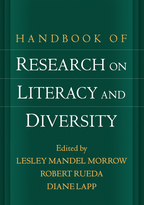Handbook of Research on Literacy and Diversity
Edited by Lesley Mandel Morrow, Robert Rueda, and Diane Lapp
Foreword by Edmund W. Gordon
Afterword by Eric J. Cooper
Introduction, Lesley Mandel Morrow, Robert Rueda, and Diane Lapp
I. Perspectives about Learning among Diverse Students
1. Relating Diversity and Literacy Theory, Honorine Nocon and Michael Cole
2. Policy Related to Issues of Diversity and Literacy: Implications for English Learners, Eugene E. Garcia and Ann-Marie Wiese
3. What Do We Know about the Discourse Patterns of Diverse Students in Multiple Settings?, Iliana Reyes, Leisy Wyman, Norma González, Eliane Rubinstein-Ávila, Karen Spear-Ellinwood, Perry Gilmore, and Luis C. Moll
4. Family Literacy: Recognizing Cultural Significance, Patricia A. Edwards, Jeanne R. Paratore, and Nancy L. Roser
5. Poverty and Its Relation to Development and Literacy, Pedro Portes and Spencer Salas
6. Language, Literacy, and Content: Adolescent English Language Learners, Robert T. Jiménez and Brad L. Teague
II. Special Issues Concerning Literacy
7. Academic English and African American Vernacular English: Exploring Possibilities for Promoting the Literacy Learning of All Children, Cynthia H. Brock, Gwendolyn Thompson McMillon, Julie L. Pennington, Dianna Townsend, and Diane Lapp
8. Engaging Diverse Students in Multiple Literacies In and Out of School, Cheryl A. McLean, Erica C. Boling, and Jennifer Rowsell
9. The New Literacies of Online Reading Comprehension and the Irony of No Child Left Behind: Students Who Require our Assistance the Most Actually Receive It the Least, Donald J. Leu, J. Gregory McVerry, W. Ian O’Byrne, Lisa Zawilinski, Jill Castek, and Douglas K. Hartman
10. Roles of Engagement, Valuing, and Identification in Reading Development of Students from Diverse Backgrounds, John T. Guthrie, Robert Rueda, Linda B. Gambrell, and Danette A. Morrison
11. Robust Informal Learning Environments for Youth from Nondominant Groups: Implications for Literacy Learning in Formal Schooling, Kris Gutiérrez and Carol D. Lee
12. Assessing Student Progress in the Time of No Child Left Behind, Georgia Earnest García and Eurydice B. Bauer
13. Meeting the Needs of Diverse Learners: Effective Management of Language Arts Instruction, D. Ray Reutzel, Lesley Mandel Morrow, and Heather Casey
III. Strategies for Teaching
14. Cross-Language Transfer of Phonological, Orthographic, and Semantic Knowledge, María S. Carlo
15. Learning to Read in English: Teaching Phonics to Beginning Readers from Diverse Backgrounds, Linnea C. Ehri
16. Vocabulary Instruction for Diverse Students, Susan Watts Taffe, Camille L. Z. Blachowicz, and Peter J. Fisher
17. Comprehension: The Means, Motive, and Opportunity for Meeting the Needs of Diverse Learners, Susie M. Goodin, Catherine M. Weber, P. David Pearson, and Taffy E. Raphael
18. Helping Diverse Learners to Become Fluent Readers, Melanie R. Kuhn and Timothy Rasinski
IV. Preparing Teachers to Teach Literacy to Diverse Students
19. Teacher Knowledge in Culturally and Linguistically Complex Classrooms: Lessons from the Golden Age and Beyond, Django Paris and Arnetha F. Ball
20. Protecting Our Investment: Induction and Mentoring of Novice Teachers in Diversity-Rich Schools, Nancy Frey and Douglas Fisher
21. Professional Development: Continuing to Understand How to Teach Children from Diverse Backgrounds, Margarita Calderón
Afterword: From "Just a Teacher" to Justice in Teaching: Working in the Service of Education, the New Civil Right, Eric J. Cooper



